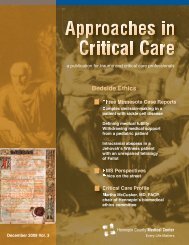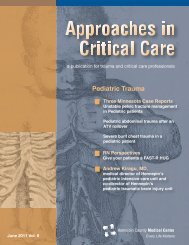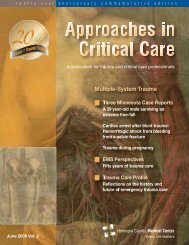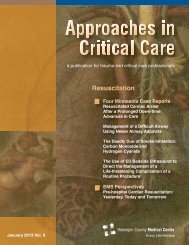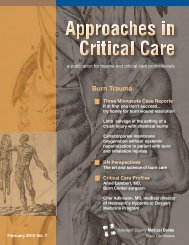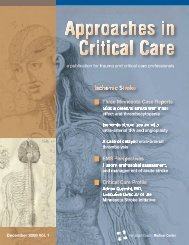Em. Med. Annual Report 2011 - Hennepin County Medical Center
Em. Med. Annual Report 2011 - Hennepin County Medical Center
Em. Med. Annual Report 2011 - Hennepin County Medical Center
Create successful ePaper yourself
Turn your PDF publications into a flip-book with our unique Google optimized e-Paper software.
A Thumbnail History of<br />
<strong>Em</strong>ergency <strong>Med</strong>icine in the U.S. and<br />
<strong>Hennepin</strong> <strong>County</strong> <strong>Med</strong>ical <strong>Center</strong><br />
The Start<br />
The National Scene Post WWII by Ernest Ruiz, MD, FACEP<br />
Access to emergency room (ER) care across the<br />
U.S. in the fifties and sixties did not keep up with<br />
the needs of the growing post-war population. The<br />
numbers of practicing physicians had not kept<br />
pace with the growth. Many people began to use<br />
the ER as their primary source of medical care.<br />
Under-staffed, under-funded, and under-equipped,<br />
ERs were serious problems for most hospitals.<br />
Practicing physicians who staffed community<br />
hospitals were pressured by demands for their<br />
time. They were on-call to the ER during their<br />
non-clinic hours. Hospitals and their affected<br />
physician staff became open to ideas that might<br />
ease the situation.<br />
In 1961, an over-burdened practicing physician,<br />
James D. Mills in Alexandria, Va., decided to limit<br />
his practice to ER coverage. He pulled together a<br />
group of like-minded physicians to cover their<br />
community hospital ER around-the-clock. They<br />
would make a modest living at it. They became<br />
"specialists" in emergency care. James Mills<br />
(1920-1989), a respected general practitioner and<br />
proper gentleman, is credited as being the "father<br />
of emergency medicine." The "Alexandria Plan's"<br />
success encouraged physicians elsewhere to get<br />
organized as well. General practitioners John G.<br />
Wiegenstein in Lansing, Mich., Ralston R. Hannas<br />
in Sentinal, Oak., and Harris B. Graves in Omaha,<br />
Neb. joined or formed similar groups and<br />
vigorously carried the message onto the national<br />
stage. They envisioned that emergency care could<br />
be improved across the U.S. if physicians who<br />
4 | Department of <strong>Em</strong>ergency <strong>Med</strong>icine Activities <strong>Report</strong> | 2009-2010<br />
chose emergency medicine as their livelihood had<br />
their own national organization. Wiegenstein<br />
(1930-2004) and seven others boldly formed a<br />
society called the American College of <strong>Em</strong>ergency<br />
Physicians (ACEP) in 1968. ACEP met in<br />
Colorado the next year and 128 physicians<br />
attended. Hannas (1918-2005) and Harris<br />
(1928-1995) had joined in. ACEP is now widely<br />
accepted as the most effective sounding board for<br />
the practice of emergency medicine while strongly<br />
encouraging scientific progress. It has over 26,000<br />
members. The vision of these few men and<br />
women lives on. They looked forward to the<br />
establishment of residency training for emergency<br />
physicians and the attainment of primary board<br />
status for emergency medicine.<br />
Academia Stumbles Forward<br />
Meanwhile, academic institutions responsible for<br />
the big-city teaching hospitals assigned<br />
responsibility for their ERs to the departments of<br />
Surgery and <strong>Med</strong>icine. Although their residency<br />
training programs provided some medical<br />
manpower, the need for clinical experience in their<br />
specialties did not justify staffing the ER solely with<br />
their residents. The ER was as serious a problem<br />
in the "city hospitals" as it was in community<br />
hospitals. Unfortunately, the inter-departmental<br />
competition for scarce resources common to<br />
teaching hospitals at that time made the common<br />
sense approach used by James Mills impossible.<br />
The obvious solution was to create a residency<br />
program for emergency medicine. This was not an<br />
option because it would have encroached on the




